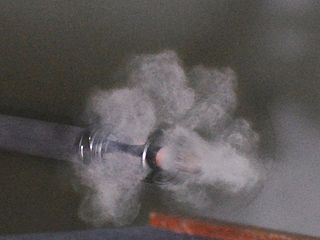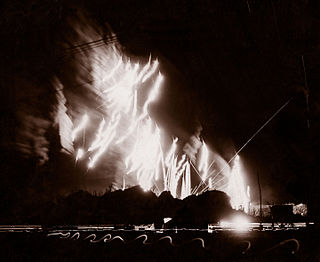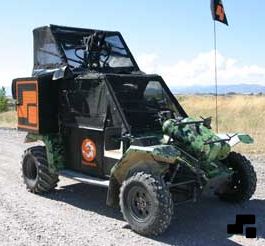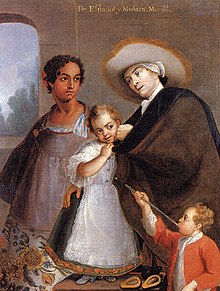
A firearm is any type of gun that uses an explosive charge and is designed to be readily carried and operated by an individual. The term is legally defined further in different countries.

A slingshot or catapult is a small hand-powered projectile weapon. The classic form consists of a Y-shaped frame, with two tubes or strips made from either a natural rubber or synthetic elastic material. These are attached to the upper two ends. The other ends of the strips lead back to a pouch that holds the projectile. One hand holds the frame, while the other hand grasps the pocket and draws it back to the desired extent to provide power for the projectile—up to a full span of the arms with sufficiently long bands.

Gouache, body color, or opaque watercolor is a water-medium paint consisting of natural pigment, water, a binding agent, and sometimes additional inert material. Gouache is designed to be opaque. Gouache has a long history, having been used for at least twelve centuries. It is used most consistently by commercial artists for posters, illustrations, comics, and other design work.

A cartridge, also known as a round, is a type of pre-assembled firearm ammunition packaging a projectile, a propellant substance and an ignition device (primer) within a metallic, paper, or plastic case that is precisely made to fit within the barrel chamber of a breechloading gun, for convenient transportation and handling during shooting. Although in popular usage the term "bullet" is often used to refer to a complete cartridge, the correct usage only refers to the projectile.
A muzzleloader is any firearm in which the user loads the projectile and the propellant charge into the muzzle end of the gun. This is distinct from the modern designs of breech-loading firearms, in which user loads the ammunition into the breech end of the barrel. The term "muzzleloader" applies to both rifled and smoothbore type muzzleloaders, and may also refer to the marksman who specializes in the shooting of such firearms. The firing methods, paraphernalia and mechanism further divide both categories as do caliber.

An air gun or airgun is a gun that uses energy from compressed air or other gases that are mechanically pressurized and then released to propel and accelerate projectiles, similar to the principle of the primitive blowgun. This is in contrast to a firearm, which shoots projectiles using energy generated via exothermic combustion (detonation) of chemical propellants, most often black powder or smokeless powder.
Airsoft, also known as survival game in Japan where it was popular, is a team-based shooting game in which participants eliminate opposing players out of play by shooting them with spherical plastic projectiles shot from airsoft guns.
Peashooter or pea shooter may refer to:

A blowgun is a simple ranged weapon consisting of a long narrow tube for shooting light projectiles such as darts. It operates by having the projectile placed inside the pipe and using the force created by forced exhalation ("blow") to pneumatically propel the projectile. The propulsive power is limited by the strength of the user's respiratory muscles and the vital capacity of their lungs.
Toy guns are toys which imitate real guns, but are designed for recreational sport or casual play by children. From hand-carved wooden replicas to factory-produced pop guns and cap guns, toy guns come in all sizes, prices and materials such as wood, metal, plastic or any combination thereof. Many newer toy guns are brightly colored and oddly shaped to prevent them from being mistaken for real firearms.

A flash suppressor, also known as a flash guard, flash eliminator, flash hider, or flash cone, is a device attached to the muzzle of a rifle that reduces its visible signature while firing by cooling or dispersing the burning gases that exit the muzzle, a phenomenon typical of carbine-length weapons. Its primary intent is to reduce the chances that the shooter will be blinded in low-light shooting conditions. Contrary to popular belief, it is only a minor secondary benefit if a flash suppressor reduces the intensity of the flash visible to the enemy.

Tracer ammunition, or tracers, are bullets or cannon-caliber projectiles that are built with a small pyrotechnic charge in their base. When fired, the pyrotechnic composition is ignited by the burning powder and burns very brightly, making the projectile trajectory visible to the naked eye during daylight, and very bright during nighttime firing. This allows the shooter to visually trace the trajectory of the projectile and thus make necessary ballistic corrections, without having to confirm projectile impacts and without even using the sights of the weapon. Tracer fire can also be used as a marking tool to signal other shooters to concentrate their fire on a particular target during battle.

A shotgun cartridge, shotshell, or shell is a type of rimmed, cylindrical (straight-walled) ammunition used specifically in shotguns. It is typically loaded with numerous small, spherical sub-projectiles called shot. Shotguns typically use a smoothbore barrel with a tapered constriction at the muzzle to regulate the extent of scattering.

A shooting range, firing range, gun range or shooting ground is a specialized facility, venue, or field designed specifically for firearm usage qualifications, training, practice, or competitions. Some shooting ranges are operated by military or law enforcement agencies, though the majority of ranges are privately owned by civilians and sporting clubs and cater mostly to recreational shooters. Each facility is typically overseen by one or more supervisory personnel, known as a Range Officer (RO), or sometimes a range master in the United States. Supervisory personnel are responsible for ensuring that all safety rules and relevant laws are followed at all times.

The International Practical Shooting Confederation (IPSC) is the world's largest shooting sport association, and the largest and oldest within practical shooting. Founded in 1976, the IPSC nowadays affiliates over 100 regions from Africa, Americas, Asia, Europe, the Middle East, and Oceania. Competitions are held with pistols, revolvers, rifles, and shotguns, and the competitors are divided into different divisions based on firearm and equipment features. While everyone in a division competes in the Overall category, there are also separate awards for the categories Lady, Super Junior, Junior, Senior, and Super Senior.
A rifled musket, rifle musket, or rifle-musket is a type of firearm made in the mid-19th century. Originally the term referred only to muskets that had been produced as a smoothbore weapon and later had their barrels replaced with rifled barrels. The term later included rifles that directly replaced, and were of the same design overall as, a particular model of smoothbore musket.

The World Pea Shooting Championships have been held annually since 1971 on the second Saturday in July, in the village of Witcham near Ely in Cambridgeshire, England, and has attracted competitors from as far afield as the USA, Canada, Scandinavia, France, Spain, New Zealand and Holland.

A paintball tank, also known as a paintball armoured vehicle (PAV) is a vehicle, or a portable structure that resembles a vehicle, sometimes used in the sport of paintball, usually with the intent of military simulation. The purpose of the tank is to provide a mobile shelter for one or several players, from which they may employ their markers against players on the opposing team. Small pneumatic guns, effectively low-powered potato cannons loaded with foam darts, are also often employed against other tanks.

A pop gun is a toy gun that was made by American inventor Edward Lewis and uses air pressure to fire a small tethered or untethered projectile out of a barrel, most often via piston action though sometimes via spring pressure. Other variants do not launch the obstruction, but simply create a loud noise. This mechanism consists of a hollow cylindrical barrel which is sealed at one end with the projectile and at the other with a long-handled plunger.
The following are terms related to firearms and ammunition topics.















